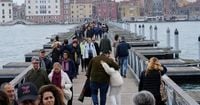Venice, a city famed for its winding canals and labyrinthine alleys, is no stranger to bridges. Yet, for the first time in years, a very special bridge has captured the hearts and footsteps of Venetians and visitors alike. In 2025, the city revived a long-dormant tradition: the construction of a temporary floating bridge to San Michele, Venice’s island cemetery, in honor of the Catholic holiday All Souls’ Day.
San Michele isn’t just any cemetery. It’s the final resting place for luminaries such as American poet Ezra Pound and Russian composer Igor Stravinsky, as well as generations of Venetians whose names are known only to their families. According to the Associated Press, the city’s decision to bring back the bridge was more than just a logistical move; it was a bid to reconnect Venetians with their history and their loved ones in a uniquely tangible way.
The tradition itself dates back to the early 19th century. Originally, the crossing was a marvel of Venetian ingenuity: local “peata” boats were lashed together, topped with wooden planks, and anchored to the lagoon bed. This makeshift bridge allowed people to walk the quarter-mile (400 meters) from the Fondamente Nove to San Michele by foot, right across the water. But as public water buses became more common in the 1950s, the floating bridge faded into memory. For decades, the only way to reach San Michele was by boat.
That changed, briefly, in 2019. The city experimented with a modular pontoon bridge, hoping to revive the custom. However, the COVID-19 pandemic soon put a halt to annual plans, and the idea was shelved—until now. In 2025, Venice brought the bridge back, determined to make it a staple of All Souls’ Day once again.
Mayor Luigi Brugnaro, speaking to reporters last week, explained the motivation behind the revival: “We have proposed it once more so we can reconnect history with living people. It’s a concrete journey. It’s not fake, not philosophical. By foot, over the water, a beautiful route that makes you understand a lot of things about Venice.” His words echo the sentiment of many Venetians, for whom the bridge is more than just a physical structure—it’s a link to tradition and memory.
Venice is a city literally built on bridges, with hundreds crisscrossing its canals. But temporary bridges are rare, reserved for only the most significant occasions. There are just two others: one across the Giudecca Canal for the annual Feast of the Redentore in July, and another across the Grand Canal for the November 21 Feast of the Madonna della Salute. Of these, the floating walkway to San Michele is the longest, stretching across a particularly shallow area of the lagoon from the Fondamente Nove, near Murano.
The modern bridge is an engineering feat in its own right. Constructed from sturdy modular pontoons, it arches upward to let water taxis, public buses, ambulances, and other boats pass beneath. Officials assured the public that it can withstand high tides of up to one meter (over three feet)—no small concern in a city where acqua alta, or high water, is a perennial threat. At 15 meters (about 50 feet) wide, the bridge is broad enough to accommodate a steady stream of foot traffic.
The bridge opened on Thursday, October 30, 2025, in anticipation of All Souls’ Day, which fell on Sunday, November 2. Traditionally, this is the day when Italians visit cemeteries to honor their deceased loved ones. In a nod to the solemnity of the occasion, only residents were permitted to use the bridge through the Sunday holiday. On Monday, November 3, the bridge opened to tourists, allowing the wider world a chance to experience this unique Venetian tradition.
For many, the bridge offered a rare and deeply personal opportunity. Antonio Vespignani, a local resident, shared his feelings with the Associated Press: “I usually don’t go to the cemetery for various reasons, but I’m taking advantage of this very rare circumstance. It’s a way for me to visit my loved ones.” His words capture the sentiment of many Venetians who, perhaps for the first time in years, could make the journey to San Michele on foot—just as their ancestors once did.
Tourists, too, found themselves drawn into the tradition, often by accident. Zhang Miao, a visitor from China, arrived on the island by ferry on Sunday, unaware that it was a cemetery. “To return to the mainland, I used the bridge, which is much more convenient and, what’s more, it’s free,” she said. Her experience underscores the bridge’s dual role: it’s both a practical solution and a living piece of history, open to all who happen upon it.
The cemetery at San Michele has a story all its own. Established in 1807, it owes its existence to Napoleon, who decreed that burials be moved away from the crowded city center for health reasons. The cemetery took its name from the island’s 15th-century church and was later expanded when a canal between neighboring islands was filled in. Today, San Michele remains the principal burial ground for Venice’s historic center, even as much of the city’s population has shifted to the mainland.
Despite these changes, the revival of the floating bridge has rekindled a sense of continuity for Venetians. It’s a physical reminder of the city’s resilience and its ability to adapt old traditions to new realities. As Mayor Brugnaro put it, the bridge is “a beautiful route that makes you understand a lot of things about Venice.” It’s hard to argue with that. For a few days each year, the city’s past and present meet on the gentle rise of a pontoon bridge, suspended between water and sky.
Venice’s floating bridge to San Michele is more than a pathway—it’s a testament to memory, community, and the enduring spirit of a city that, despite the tides of time, still finds ways to bring its people together.

